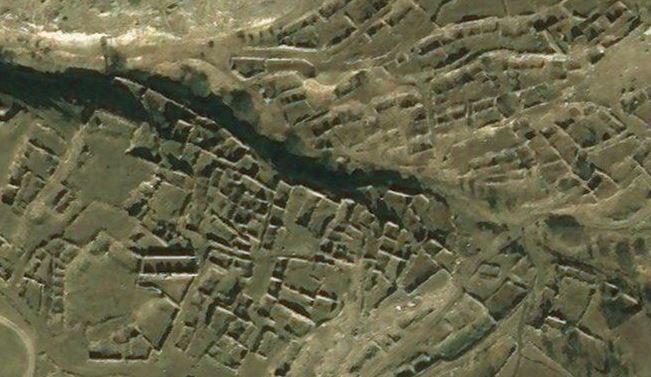This Google Map shows the past and present Jewish settlements in Birobidzhan (also transliterated from the Russian as Birobidjan and Birobijan), the so-called Jewish Autonomous Oblast of Russia.
Birobidzhan was named after the Bira and the Bidzhan, the two main local tributaries of the Amur, which forms the southern border of the oblast and divides it from Manchuria in China. The region is very remote and was sparsely populated – before the move to settle Jews here in the late 1920s, there were only some Cossack villages and a small Korean population. Consolidating the border zone was one of the Soviets’ reasons behind encouraging immigration.
Birobidzhan was settled with some optimism and idealism in the late 1920s, although this may have been misplaced – the new settlements were overwhelmingly agricultural enterprises and many of the settlers were lacking in the necessary experience and skills and became urbanised instead. As a result, some of the early agricultural settlements such as Pompeyevka were abandoned over time. The riverside collective farm at Stalinsk (Stalinfeld) was abandoned for a different reason, due to severe flooding by the Amur in 1958.
The Jewish Autonomous Oblast suffered, like the rest of Russia, during the Soviet purges and in 1937-1940 (and later) many local Jews in Birobidzhan were arrested on usually fabricated charges and prosecuted and in some cases executed.
For example, looking at Stalinsk we find the following accused Jewish residents of the collective farm. Spellings of names are mostly a direct transliteration from the Russian (in which language the preference is to render proper nouns phonetically), so may differ from the normal spellings in the Latin alphabet. The Russian use of the otchestvo (patronymic) clearly helps in identifying an individual, so that e.g. Mordukh Abramovich Ekelchik is Mordukh Ekelchik, the son of Abram. The places of birth are given, anachronistically, to show the present-day location, and indicate how diverse the places of origins of these Jewish settlers were.
Mordukh Abramovich Ekelchik. Born in Minsk, Belarus in 1880. Farm produce distributor. Arrested 18 Oct 1937, shot 29 Jan 1938.
Khaim Yakovlevich Kab. Born in London, England in 1905. Tractor driver. Arrested 12 Dec 1938, case dismissed for want of evidence 29 May 1940.
Shimon Iosifovich Shef. Born in Zhytomyr, Ukraine in 1894. Loader on grain farm. Arrested 14 Oct 1937, sentenced to 10 years 31 Dec 1937.
Isaak Tevelevich Sukhoy. Born in Dubăsari, Moldova in 1899. Arrested 12 Mar 1938, sentenced to 6 years 21 Oct 1938.
Lev Yankelevich (or Yakovlevich) Zhak. Born in Ukmergė, Lithuania in 1901. Fire chief on grain farm. Arrested 3 Dec 1938.
And below are some of the Jewish victims from the small settlement of Smidovich:
Moses Fimelevich (or Fishelevich) Berezovsky. Born in Brest, Belarus in 1901. Russian Red Cross oficial. Arrested 20 Nov 1937, sentenced to 10 years 4 Jan 1938.
Moisza Abramovich Bykhovsky. Born in Panevėžys, Lithuania in 1915. Turner. Arrested 28 Dec 1937, case dismissed 3 Apr 1939.
Henrietta Moiseevna Fiks. Born in Daugavpils, Latvia in 1908. State bank accountant. Arrested 11 Jul 1938, sentenced to 8 years 22 Oct 1938.
Israel Isaakovich Fishbein. Born in Uzda, Belarus in 1907. Secretary. Arrested 26 Oct 1937, case dismissed 13 Nov 1939.
Rakhil Ioselevna (or Moiseevna) Gamarskaya. Born in Vilnius, Lithuania in 1898. Instructor. Arrested 23 Nov 1937, sentenced to 5 years 27 Jul 1938.
Shaya Solomonovich (or Sholomovich) Gilinsky. Born in Poland in 1906. Agronomist. Arrested 7 Jul 1937, sentenced to 10 years 22 Oct 1938.
Khaim Peisakhovich (or Teisanovich) Kaplan. Born in Shchadryn (Shchedrin), Belarus in 1902. Party official. Arrested 3 Feb 1938, case dismissed 21 Mar 1938.
Bluma Isaakovna Meerbaum. Born in Romania in 1908. Jewish elementary school teacher. Arrested 15 Feb 1938, sentenced to 10 years 27 Jul 1938.
Zusman Ioselevich Perevozkin. Born in Vilnius, Lithuania in 1903. Chairman. Arrested 23 Nov 1937, convicted 18 Jul 1938, shot 16 Aug 1938 in Khabarovsk.
Sara Mikhailovna Shtern or Stern. Born in Ostroh, Ukraine in 1896. Party propagandist. Arrested 6 Jul 1938, case dismissed 16 Jan 1939.
Grigory Samoilovich Vasilevsky. Born in Moscow, Russia in 1913. Foreman of the collective farm. Arrested 10 Jan 1949, sentenced to 10 years 24 Dec 1949.
Shaya Srulevich Verkhivker. Born in Voznesensk, Ukraine in 1888. Official. Arrested 21 Oct 1937, sentenced to 15 years 11 Nov 1937.
Ilya Mikhailovich Zimmerman. Born in Chernovin (possibly Chernobyl intended?), Ukraine in 1904. Director. Arrested 31 Mar 1937, convicted 17 Jul 1937, shot 17 July 1937 in Khabarovsk.
Despite increases in population into the 1940s, over time the Jewish population diminished through out-migration, a phenomenon which inevitably increased when the USSR dissolved and emigration beyond the Soviet Union became a possibility. Today, the only notable known Jewish centres of population are in the capital Birobidzhan and in the nearby village of Valdgeym. However, during the time of the USSR with its aggressively secular ethos, it is likely that there were mixed marriages and assimilation, so that mainly ostensibly Russian individuals in the oblast may have partly Jewish roots.






You must be logged in to post a comment.